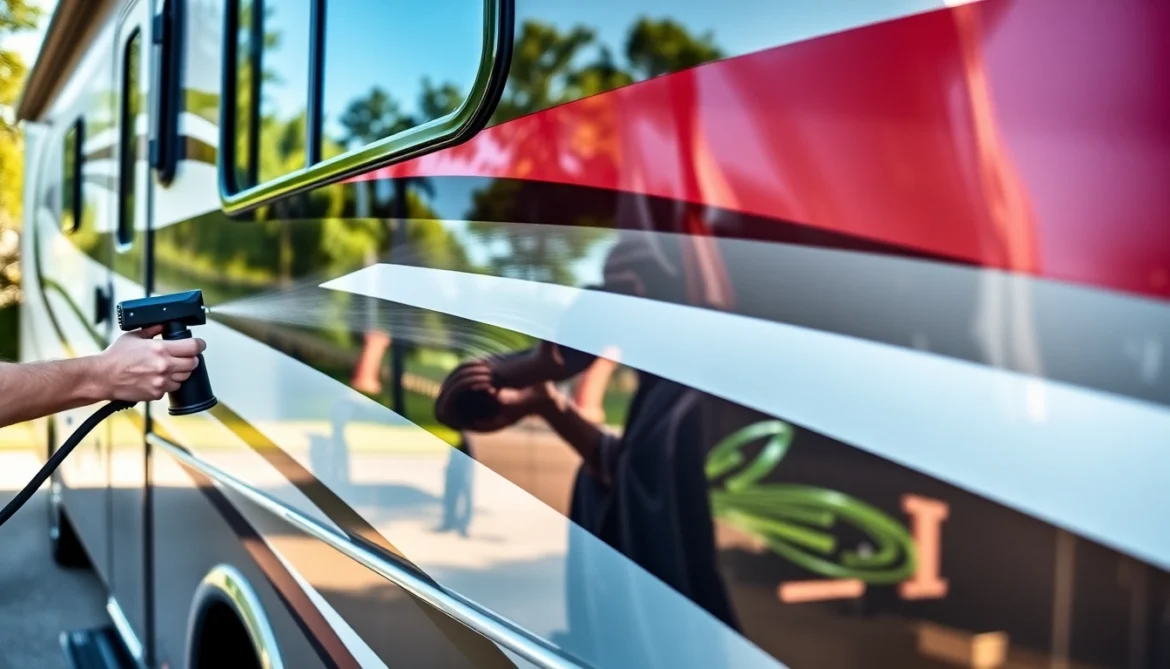Introduction to RV Polishing Sealant
Protecting and maintaining the exterior appearance of your motorhome is crucial for preserving its value, extending its lifespan, and ensuring an impressive look on every journey. Among the various methods available, applying a Wohnmobil Politursiegelung stands out as a highly effective solution. Unlike traditional waxing or ceramic coatings, polishing sealants offer a perfect balance of ease of application, durability, and economic efficiency.
This article provides a comprehensive guide to RV polishing sealants, including their benefits, application techniques, and how they compare to other protective options. Whether you’re a seasoned RV enthusiast or new to vehicle care, understanding the nuances of polishing sealants will help you make informed decisions to keep your motorhome looking pristine for years to come.
What is an RV Polishing Sealant?
An RV polishing sealant is a protective product designed to create a glossy, durable barrier on the surface of your motorhome. It combines the properties of a polish—restoring shine and removing minor imperfections—with the durability of a sealant that repels water, dirt, and other environmental contaminants. This dual function ensures both aesthetic enhancement and long-term protection.
Unlike ceramic coatings, which typically involve multi-stage application processes and curing times, polishing sealants are often easier to apply, making them suitable for both DIY enthusiasts and professional detailers. They contain micro-fine polymers and resins that adhere tightly to the surface, providing a high-gloss finish that can last several months depending on environmental conditions and maintenance routines.
Benefits of Polishing Sealants for Motorhomes
Choosing a polishing sealant offers several distinct advantages for RV owners:
- Enhanced Appearance: Restores and maintains a deep, mirror-like shine that accentuates the vehicle’s paintwork or gelcoat.
- Hydrophobic Effect: Creates a water-repellent surface that helps water bead and roll off, reducing water spots and mineral deposits.
- Protection Against Environmental Damage: Shields against UV rays, acid rain, dirt, road salts, and bird droppings, which can cause surface degradation over time.
- Ease of Application: Generally straightforward and quick, suitable for application with basic tools and minimal expertise.
- Cost-Effectiveness: Offers a good compromise between the more expensive ceramic coatings and traditional waxes, delivering durability without requiring extensive curing or reapplication.
Regular application of a quality polish sealant can significantly reduce the frequency and intensity of cleaning sessions, saving time and effort while keeping the RV in top condition.
Types of Polishing Sealants and Their Characteristics
Synthetic Polymer Sealants
Synthetic polymer-based sealants are the most common. They form a chemical bond with the surface, providing high durability and significant water-repellent properties. These products typically last 3-6 months and are ideal for seasonal protection.
Carnauba-Enhanced Sealants
Combining natural carnauba wax with synthetic polymers offers a balance of shine and protection. While less durable than pure synthetics, they deliver an impressive gloss and easier removal.
Hybrid Formulations
Many modern sealants incorporate both synthetic and natural ingredients, optimizing for longevity, ease of use, and aesthetic appeal.
When selecting a product, consider your specific needs regarding durability, gloss, and ease of application.
Application and Maintenance of RV Polishing Sealants
Step-by-Step Application Guide
- Preparation: Thoroughly wash your RV with a gentle, high-quality cleaner like BCC Power Cleaner to remove dirt, grime, and surface contaminants. Use a foam gun (e.g., BCC Snow Foam Gun) to ensure uniform cleaning.
- Decontamination & Claying: Use a clay bar or decontamination spray to eliminate embedded contaminants for a smooth surface.
- Polishing: If needed, use a mild polish or compound to remove swirl marks or oxidation, ensuring a flawless base.
- Applying the Sealant: Use an applicator pad or microfiber towel to evenly spread the polishing sealant. Work in small sections, buffing lightly after the recommended curing time.
- Final Buffing: Use a clean, soft microfiber towel (such as BCC Microfaser Towel) to remove excess product and enhance gloss.
Post-Application Tips
- Avoid washing the RV for at least 24 hours after application.
- Use gentle, pH-neutral shampoos for ongoing cleaning to preserve the Sealant’s integrity.
- Regularly inspect the surface and reapply the sealant every 4-6 months, depending on exposure and wear.
Maintaining the Sealant’s Performance
For sustained protection, consider using specialized products like MARINE SEALANT MS-3000/60 V2 for long-term sealant reinforcement or quick detailers designed to boost hydrophobicity between sealant applications.
Comparison: Polishing Sealant vs. Ceramic Coating
Pros and Cons of Polishing Sealants
Advantages include easier application, lower cost, and the ability to remove or reapply with minimal surface preparation. They are also more forgiving for DIY application, making them accessible to a broader audience.
However, their durability typically ranges from 3 to 6 months, and they may require more frequent reapplication to maintain optimal protection.
Long-Term Durability of Ceramic Coatings
Ceramic coatings, such as those supported by professional application, create a covalent bond with the surface, providing protection that can last 2-5 years or more. They offer excellent chemical and UV resistance but involve higher costs and more extensive application procedures.
Cost and Investment Considerations
While polishing sealants are budget-friendly and suitable for regular maintenance, ceramic coatings represent a longer-term investment, ideal for RV owners seeking maximum durability and minimal maintenance over several years.
Choosing the Right RV Polishing Sealant
Key Quality Indicators and Certifications
Select products with proven performance, third-party testing, and certifications such as ISO or industry-standard test results. Products like BCC Power Sealer are formulated for high performance and extended protection.
Customer Feedback and Reviews
Look for reputable brands with positive user reviews that highlight ease of use, finish quality, and durability. For instance, feedback on products such as BCC Towels Vorteilspack and coating systems can guide you towards reliable choices.
Recommended Products for RVs
Top products include maintenance-friendly formulations like BCC Power Sealers, quick application options like spray sealants, and professional-grade kits with applicators and polishing pads.
Frequently Asked Questions about RV Polishing Sealant
How often should the polishing sealant be reapplied?
Typically, reapplication every 4 to 6 months ensures consistent protection, though this depends on exposure to elements like sun, rain, and road debris.
Can all RV surfaces be sealed?
Most gelcoat, painted, and plastic surfaces are compatible, but always verify compatibility before application, especially on matte or textured surfaces.
What is the cost difference between polishing sealants and ceramic coatings?
Polishing sealants are generally affordable, often under €50 for quality products, whereas professional ceramic coatings can cost between €1,000 to €3,000 depending on size and complexity. The choice depends on your budget and long-term protection goals.

